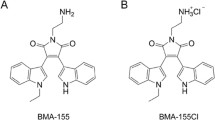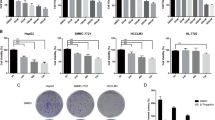Abstract
The antitumor effects and molecular mechanism of NPC-16, a novel naphthalimide–polyamine conjugate, were evaluated in HepG2 cells and Bel-7402 cells. Apoptosis and necrosis were evaluated by Annexin V-FITC detection kit, and autophagy by acridine orange and Lyso-Tracker Red staining. The change of mitochondrial transmembrane potential was measured using rhodamine 123 staining. The protein expression of Beclin 1, LC3 II and mTOR, p70S6 K, 14-3-3, caspase, and Bcl-2 family members was detected by immunofluorescence assays and Western Blot. Here, we elucidated the nature of cellular response of HepG2 cells and Bel-7402 cells to NPC-16 at IC50. NPC-16 induced caspase-dependent apoptosis via the mitochondrial pathway and death receptor pathway in Bel-7402 cells. Differently, NPC-16 triggered HepG2 cells both apoptosis and autophagy, further autophagy facilitated cellular apoptosis. Furthermore, mTOR signal pathway was involved in NPC-16-mediated autophagy in HepG2 cells. Thus, NPC-16 may be useful as a potential template for investigation the molecular mechanism of naphthalimide–polyamine conjugate against hepatocellular carcinoma.




Similar content being viewed by others
Change history
03 February 2021
A Correction to this paper has been published: https://doi.org/10.1007/s10495-021-01658-0
References
Veiseh O, Kievit FM, Gunn JW, Ratner BD, Zhang M (2009) A ligand-mediated nanovector for targeted gene delivery and transfection in cancer cells. Biomaterials 30:649–657
Garcia G, Sol V, Lamarche F, Granet R, Guilloton M, Champavier Y (2006) Synthesis and photocytotoxic activity of new chlorin-polyamine conjugates. Bioorg Med Chem Lett 16:3188–3192
Delcros JG, Tomasi S, Duhieu S, Foucault M, Martin B, Le Roch M (2006) Effect of polyamine homologation on the transport and biological properties of heterocyclic amidines. J Med Chem 49:232–245
Casero RA, Marton LJ (2007) Targeting polyamine metabolism and function in cancer and other hyperproliferative diseases. Nat Rev Drug Discov 6:373–390
Phanstiel O IV, Kaur N, Delcros JG (2007) Structure-activity investigations of polyamine–anthracene conjugates and their uptake via the polyamine transporter. Amino Acids 33:305–313
Barret JM, Kruczynski A, Vispé S, Annereau JP, Brel V, Guminski Y (2008) F14512, a potent antitumor agent targeting topoisomerase II vectored into cancer cells via the polyamine transport system. Cancer Res 68:9845–9853
Malviya VK, Liu PY, Alberts DS, Surwit EA, Craig JB, Hanningan EV (1992) Evaluation of amonafide in cervical cancer, phase II: a swog study. Am J Clin Oncol 15:41–44
Tian ZY, Xie SQ, Du YW, Ma YF, Zhao J, Gao WY (2009) Synthese, cytotoxicity and apoptosis of naphthalimide–polyamine conjugates as antitumor agents. Eur J Med Chem 44:393–399
Xie SQ, Wang JH, Ma HX, Cheng PF, Zhao J, Wang CJ (2009) Polyamine transporter recognization and antitumor effects of anthracenymethyl homospermidin. Toxicol 263:127–133
Arthur CR, Gupton JT, Kellogg GE, Yeudall WA, Cabot MC, Newsham IF (2007) Autophagic cell death, polyploidy and senescence induced in breast tumor cells by the substituted pyrrole JG-03-14, a novel microtubule poison. Biochem Pharmacol 74:981–991
Sundelin SP, Terman A (2002) Different effects of chloroquine and hydroxychloroquine on lysosomal function in cultured retinal pigment epithelial cells. APMIS 110:481–489
Tsai AC, Pan SL, Sun HL, Wang CY, Peng CY, Wang SW (2010) CHM-1, a new vascular targeting agent, induces apoptosis of human umbilical vein endothelial cells via p53-mediated death receptor 5 up-regulation. J Biol Chem 285:5497–5506
Palmer AJ, Wallace HM (2010) The polyamine transport system as a target for anticancer drug development. Amino Acids 38:415–422
Ralton LD, Bestwick CS, Milne L, Duthie S, Kong Thoo Lin P (2009) Bisnaphthalimidopropyl spermidine induces apoptosis within colon carcinoma cells. Chem Biol Interact 177:1–6
Schipper RG, Penning LC, Verhofstad AA (2000) Involvement of polyamines in apoptosis. Facts and controversies: effectors or protectors? Semin Cancer Biol 10:55–68
Xie SQ, Wu YL, Cheng PF, Wang MW, Liu GC, Ma YF, Zhao J, Wang CJ (2007) A novel homospermidine conjugate inhibits growth and induces apoptosis in human hepatoma cells. Acta Pharmacol Sin 28:1827–1834
Tian ZY, Xie SQ, Mei ZH, Zhao J, Gao WY, Wang CJ (2009) Conjugation of substituted naphthalimides to polyamines as cytotoxic agents targeting the Akt/mTOR signal pathway. Org Biomol Chem 7:4651–4660
Jung CH, Ro SH, Cao J, Otto NM, Kim DH (2010) mTOR regulation of autophagy. FEBS Lett 584:1287–1295
Djavaheri-Mergny M, Maiuri MC, Kroemer G (2010) Cross talk between apoptosis and autophagy by caspase-mediated cleavage of Beclin 1. Oncogene 29:1717–1719
Qian WB, Liu JQ, Jin J, Ni WM, Xu WL (2007) Arsenic trioxide induces not only apoptosis but also autophagic cell death in leukemia cell lines via upregulation of Beclin-1. Leuk. Res 31:329–339
Zhang Y, Wu Y, Tashiro S, Onodera S, Ikejima T (2009) Involvement of PKC signal pathways in oridonin-induced autophagy in HeLa cells: a protective mechanism against apoptosis. Biochem Biophys Res Commun 378:273–278
NJr Hail (2005) Mitochondria: a novel target for the chemoprevention of cancer. Apoptosis 10:687–705
Tang HJ, Jin X, Wang S, Yang D, Cao Y, Chen J (2006) A small molecule compound inhibits AKT pathway in ovarian cancer cell lines. Gynecol Oncol 100:308–317
Holst CM, Johansson VM, Alm K, Oredsson SM (2008) Novel anti-apoptotic effect of Bcl-2: prevention of polyamine depletion-induced cell death. Cell Biol Int 32:66–74
Holst CM, Staaf J, Jönsson G, Hegardt C, Oredsson SM (2008) Molecular mechanisms underlying N1, N11-diethylnorspermine-induced apoptosis in a human breast cancer cell line. Anticancer Drugs 19:871–883
Xie SQ, Liu GC, Ma YF, Cheng PF, Wu YL, Wang MW, Zhao J, Wang CJ (2008) Synergistic antitumor effects of anthracenylmethyl homospermidine and alpha-difluoromethylornithine on promyelocytic leukemia HL60 cells. Toxicol In Vitro 22:352–358
Zha J, Harada H, Yang E, Jockel J, Korsmeyer SJ (1996) Serine phosphorylation of death agonist BAD in response to survival factor results in binding to 14-3-3 not BCL-XL. Cell 87:589–592
Acknowledgments
This work was supported by National Natural Science Foundation of China (No. 20872027; 90913001), Projects of Science and Technology of Henan (No. 0821022700; 072102330028), China Postdoctoral Science Foundation Funded Project (No. 20090450092).
Conflict of interest
All authors have no personal or financial conflict of interest and have not entered into any agreement that could interfere with our access to the data on the research, or upon our ability to analyze the data independently, to prepare manuscripts, and to publish them.
Author information
Authors and Affiliations
Corresponding author
About this article
Cite this article
Xie, Sq., Li, Q., Zhang, Yh. et al. RETRACTED ARTICLE: NPC-16, a novel naphthalimide–polyamine conjugate, induced apoptosis and autophagy in human hepatoma HepG2 cells and Bel-7402 cells. Apoptosis 16, 27–34 (2011). https://doi.org/10.1007/s10495-010-0537-1
Published:
Issue Date:
DOI: https://doi.org/10.1007/s10495-010-0537-1




